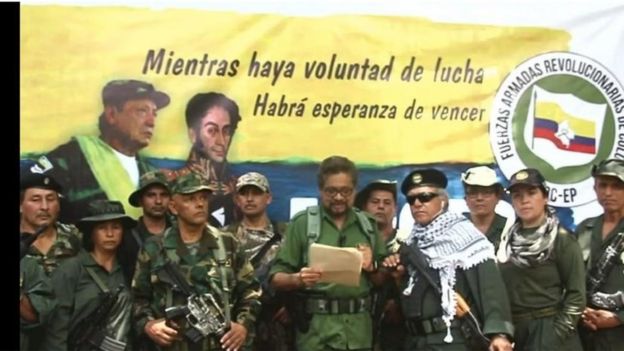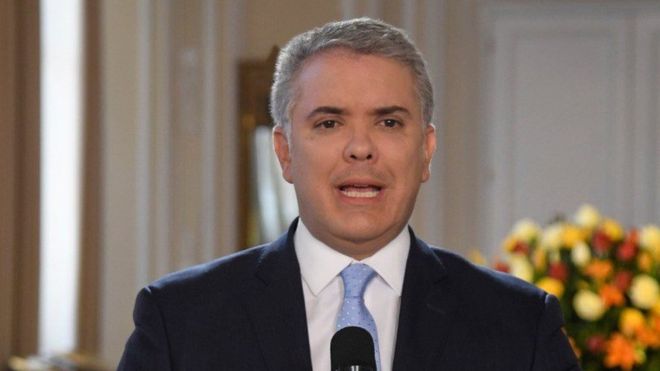Colombia’s president has vowed to hunt down Farc rebel commanders who have called on followers to take up arms after three years of peace.
President Iván Duque offered $882,000 (£725,000) for the capture of each of the rebels who appeared in a video with former Farc commander Iván Márquez.
He was one of the main negotiators of the 2016 peace deal, which ended 50 years of conflict.
But now the former commander has accused the government of “betrayal”.
“In two years, more than 500 social leaders have been killed and 150 guerrilla fighters are dead amidst the indifference and the indolence of the state,” Ivan Márquez says in the 30-minute video, referring to the high number of activists and former Farc members killed since President Duque took office.
But President Duque hit back later on Thursday, accusing the rebels of being “narco-terrorists who have the shelter and support of the dictatorship of Nicolás Maduro”, president of neighboring Venezuela.
What does the rebel video show?
It shows Iván Márquez reading out a statement in front of a banner saying: “While there is a will to fight, there’ll be the hope of winning”.
- Who are the FARC?
- Inside a Farc rebel camp
- ‘If I keep quiet, I become an accomplice’
He is surrounded by about a dozen men and women dressed in camouflage. Among them are two other senior former Farc rebels, Jesús Santrich, and the man known as El Paisa.
Ivan Márquez says that he called for a return to arms because the Colombian state had “betrayed” the peace agreement he helped negotiate.

In the recording, he also says that the new guerrilla group, which carries the old name, Farc-EP (Revolutionary Armed Forces of Colombia – People’s Army), will pursue different tactics.
He says that the group will only “respond to offensives” and that it will not carry out kidnappings for ransom but instead “seek dialogue” with local landowners and business people to try to convince them to “contribute” to their cause.
The video ends with Jesús Santrich shouting “Long live the Farc-EP!”
What did the president say?
President Duque has appeared on national television, announcing “the creation of a special unit” to help track the rebels, boosted by “reinforced intelligence, investigation and mobility capabilities throughout Colombian territory”.
- Why has Colombia seen a rise in activist murders?
- Colombia urged to do more to protect ex-Farc rebels after killings
- Colombia’s former child rebels try to rebuild their lives
He said Ivan Márquez’s announcement was not “the birth of a new guerrilla movement”, but a “criminal” enterprise backed by Mr. Maduro.
“Let’s not fall into the trap of those who today are trying to hide behind false ideological clothing to sustain their criminal scaffolding,” he added, according to news agency AFP.
Who are the FARC?
The Revolutionary Armed Forces of Colombia (Farc, after the initials in Spanish), Colombia’s largest rebel group, were founded in 1964 as the armed wing of the Communist Party and follow a Marxist-Leninist ideology.
Their main founders were small farmers and land workers who had banded together to fight against the staggering levels of inequality in Colombia at the time.
While the FARC have some urban groups, they have always been an overwhelmingly rural guerrilla organization.
The Farc’s decades-long armed struggle

1964: Set up as armed wing of Communist Party
2002: At its height, it has an army of 20,000 fighters controlling up to a third of the country
2008: The Farc suffers a series of defeats in its worst year
2012: Start of peace talks in Havana
2016: Peace deal signed in November
2017: Farc officially ceases to be an armed group
2019: Former commander Iván Márquez announces “a new phase of the armed struggle”
Is the Farc back now?
Many would argue it has never completely gone away. While the group’s leaders signed a peace deal and almost 7,000 of their fighters handed in their weapons, there have been groups of dissidents that never stood down.
The number of dissidents is hard to estimate, but the figure cited in a leaked military document earlier this year was 2,300.
Some of these dissidents never laid down their weapons, others have returned and yet others are new recruits. But so far, they have been scattered around the country in dozens of small groups.
Tuesday’s video showing three former influential commanders could be a sign that these groups are joining forces and will again act as one rebel group.





























